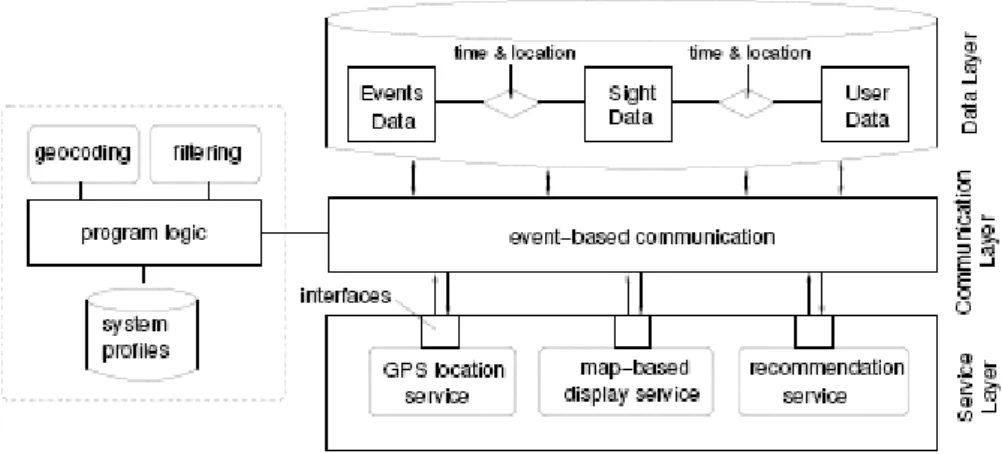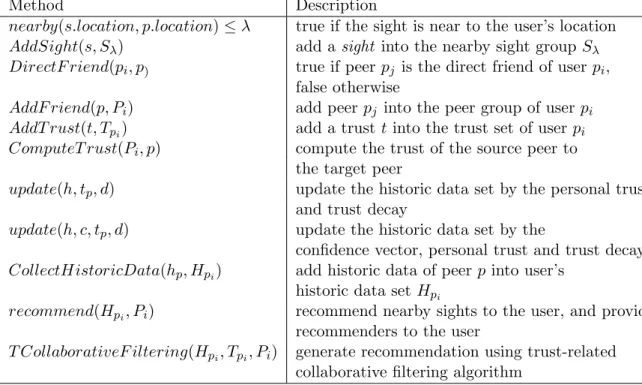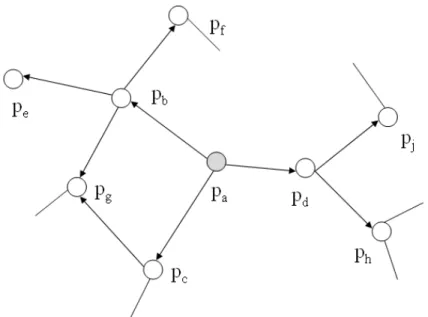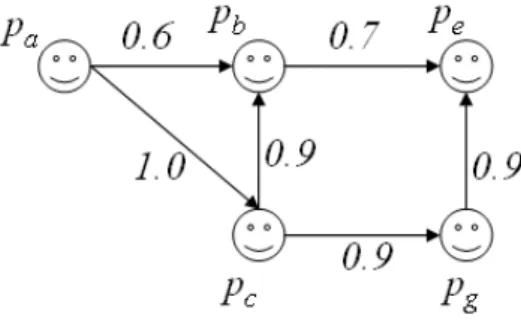Motivation
Aims and Objects
Thesis Outline
Recommender System
Six measurements for analyzing recommender algorithms
Since user preferences are different, the number of items the user has selected in the past only counts the small amount of total items in the system. In addition to the six metrics mentioned above, Recall and Precise are the other two criteria applied to measure recommender accuracy. Some research papers are also using recall and precision to measure recommendation quality.
Analyzing Content-based filtering and Collaborative filtering 10
If the user's historical information is sparse (the user did not rate one or two items or only rated one or two items), this should affect the quality of the recommended result. Through GPS device on the mobile phone, the geographical information about the user's current location will be recorded. This includes tagging the user's current location, displaying the nearby attractions as well as the viewing context.

Summary
A client can be thin or thick depending on the services required by the user. This chapter will initially clarify the concept of trust, followed by an explanation of why trust can solve the problems that exist in the recommended system (discussed in Chapter 2), and then give a description of trust in TIP, as well as the problems and challenges recommendations for TIP based on trust.
Trust concept
In the real world, trust is created during human exchange [11] and people like to act on recommendations from trusted people (their peer groups). In this case, trust acts as reputation in the system [14], which is used to guide readers. Similarly in the field of e-commerce, such as Amazon.com, the reputation of the product is calculated by the number of starts given by the habit or reader.
Trust can solve the problems
TRUST PROBLEMS AND CHALLENGES of the different users; while reputation is an attribute of the peer assigned by the embedded social network [14], it means each user in the system will be assigned a global value of reputation by the system. TRUST CAN SOLVE THE PROBLEMS 21 The computational cost of the Trust-based algorithm exists in the different aspect with the agreement-based algorithm. For the similarity-based recommendation, the computational complexity depends critically on the amount of information (the total number of users in the system and the number of recommended items) and the algorithm used.
However, the computational scale for generating recommendations in trust-based algorithm is smaller because the amount of data involved in recommendation generation is completely dependent on the size of the peer group, although the large size of the peer group causes more intensive data processing, the coverage of the peer group hardly reaches 1. Moreover, the size of the peer group can be easily controlled either by the user or the system, it is possible to find a trade-off to balance the computational intensiveness and the quality of the recommended results. Furthermore, the computational complexity of the trust-based algorithm must also include the trust generation for each user.
When the recommended items turn out to be bad, it is difficult for the user to interact with the system to influence the results. But trust-based algorithm presents the user with a transparent procedure, the user can simply interact with the system in a few ways, such as expanding or narrowing the size of the peer group, issuing explicit trust to each peer, or trying to influence the order of recommended items in different types of trust. Data sparsity will cause problems with the quality of recommendation when using trust-based algorithm.
Our goal is not only to generate personalized recommendations to meet the needs of each individual user, but also to increase user acceptance of the results in order to increase user confidence in the system.
Trust in TIP
Following the trust network, a trust score can be predicted from the user to an unknown. Trust-based recommender system focuses on analyzing peers' behavior and then recommends topics that peers like to the user. According to the research paper [15], the local trust (personal trust) achieves higher accuracy than a global one (reputation trust).
In general, the local trust can be more precise and tailored to the individual user, but the computational cost is more expansive, as the system must work out the trust for each individual user. This thesis focuses on studying the personal trust, trust propagation, the calculation of the trust and builds a trust model that specifies to propose travel information. The review system allows each user to publish individual reviews about attractions, all reviews are public to all users in the system.
A single user's reputation is calculated based on the ratings of other users' user reviews. On the other hand, introducing reputation into the system can encourage users to behave well, in other words, make users responsible for their behavior in the online society. While the credibility of reputation may not be compatible with the personal trust, the share of user coverage is higher than the personal trust, usually close to 1 [15] , and the computation cost is much lower than the personal trust, as the system only need to run the algorithm once to gain the reputation of all users.
For example, if the traveler lives in China and currently has a trip in New Zealand, most suggestions from Chinese friends may not be useful for the traveler.
Problems and challenges of Trust-based recommendation in
Introducing the trust in the trust-based recommendation system can create more personalized and accurate recommendation to meet the user's requirements. To make the recommended source ready, it is necessary to present the user with a chain of trust for the source peer to the target peer. Get recommendations from the user's peer group, which includes direct and indirect peers together.
Psychologically, the user likes to take the suggestions of the friends they are quite close to the user. In this approach, the top-recommended sight must match the user's taste closely, and the recommender must win the high trust of the user. First, the user can directly select friends from the system, if the user knows some.
Second, the user can select unknown friends in the trust mediation based on their recommendations. The trust value should be automatically updated according to the user's opinion about the recommended sights. We can assess the user's satisfaction based on feedback scores about the vision.
For example, if the feedback score is above 7 (the feedback range is from 0 to 10), say the user completes the recommendation, the system can automatically increase the trust value of the peer who gave the recommended view as it increases. the trust value of the source peer to the target peer in the corresponding view subject.
Summary
Terms and Definitions
From the point of view of trust, we call reputation as reputational trust that corresponds to personal trust (local trust). Consequently, personal trust can propagate along the trust path only if the peer has at least one friend. We define that the decrease in trust from the source peer to each direct friend is 1.
When a third peer is added towards the end of the trust path, the trust decay from the source peer to the third one will be (1−d), where ∈[0,1]. For this reason, trust decay is closely related to the number of steps between two peers on the trust path. By expanding the trust network, the source peer can connect with the unknown peers, and the peer group also grows.
Solid edges indicate that two peers have a direct trust relationship (they are direct friends), they are already connected by the trust result, and the dashed line means that two peers are indirectly connected (they are indirect friends ), the trust of the source peer with the target peer can be predicted along with the trust path. It can also be observed from the trust network that the source peer can reach the target peer through different paths. How to calculate the value of trust and establish the trust path between source peers and target peers from a given personal trust network is the core issue of the concept of trust.
Four steps are required to calculate the confidence value T of the source peer against a target peer on a given pathρ. a) Find the personal trust value associated with each targeted edge on the given path.

Trust-based Recommendation generation
Before creating a recommendation from a historical Hpi data set, we need to aggregate the data into Hpi. If the user wants to get recommendations from friends and friends of friends who are indirect friends of the user, the historical data set must be expanded to include information from indirect friends. Perform the above process recursively, the user's peer group will include more peers, similarly, the historical data set is also increased.
As a result, the confidence-based recommendation can be recreated after analyzing the extended historical data set. After updating Hi0 with confidence values, the recommendation can be generated from the confidence-based historical data set Ht. Perform the above procedure recursively, the user's peer group can include multiple trusted peers, and the historical data set can be expanded and updated along with the peer group and the trust.
FORMING RECOMMENDATIONS ON ADVICE TRUST The updated historical data gathered by personal trust can be considered as containing the user's individual recommender preferences. First, create a Pi user peer group; second, build the confidence matrix CM atrixpi; third, using the confidence matrix to update the extracted historical data set from Hpi to Hpci; end up creating a recommendation from a set of historical data based on a confidence matrix. If the user expands the peer group to include implicitly trusted peers, the recommendations will be re-generated from the expanded trust-based Hc historical data set.
According to the recommendation generated from the trust-based historical data set, it should be closer to the user's wishes and easier to be accepted than the other approach.

Summary
Trust-based application Architecture
Looking for the peer group of the user
Recommendation generation along with the trust concept
Recommendation generation based on the confidence matrix . 53
Summary
Transparency
New-user problems
Computational complexity
Data sparseness
User control
Malicious attack
Summary



